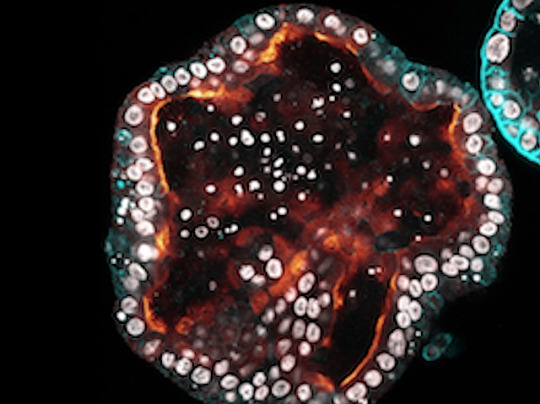#nephropathy
Text

Tubuloid Cells
Tubuloids – long-term expanding organoids lab-grown from human kidney tissue or urine – model the complexity of the kidney and enable detailed studies of renal function in health and disease, such as of lithium-induced nephropathy
Read the published research article here
Image from work by Fjodor A. Yousef Yengej and colleagues
Hubrecht Institute for Developmental Biology and Stem Cell Research-KNAW & University Medical Center Utrecht, 3584 CT Utrecht, the Netherlands
Image originally published with a Creative Commons Attribution 4.0 International (CC BY 4.0)
Published in Cell Reports, December 2023
You can also follow BPoD on Instagram, Twitter and Facebook
7 notes
·
View notes
Text

[Nephropathy.]
3 notes
·
View notes
Text
everyone is in the hospital today. My aunt’s in her 10th hour of labor with this baby- at her own insistence, she refuses any alternatives. My grandma passed out in her living room on our way to get her to see my aunt. My brother was already in hospital, but had to be taken into the emergency room all of a sudden on our way over- we got a call from the hospital and thought it was something about the baby, but turns out one of the holes in his kidney has opened back up- apparently one appeared in his liver too. Its a lot right now.
Mom keeps yelling at me in the waiting area in between yelling at hospital staff- about incompetence in “these liberal run hospitals that care more about killing babies than birthing them” (her words, not mine) about dad leaving her behind with two kids and a house to take care of, about me not doing enough. She’s panicking. She was like this when they first discovered the holes in Ed’s kidney, she was like this when dad died. It still sucks. Everything sucks today. And I know nothing I do- even if I were to disappear- will help.
#personal#family drama#hospital#medical problems#nephropathy#non diabetic#ventricular septal defect#medical mystery
1 note
·
View note
Text
0 notes
Text
Membranous Nephropathy | Rare Kidney Diseases Market | Market Size - 2035
The rare kidney diseases market, driven by a strong 125+ molecules pipeline, is projected to increase at over 15% CAGR in the coming years. The Roots Analysis report features an extensive study of the latest market landscape and the likely future potential associated with the membranous nephropathy market. One of the key objectives of this report was to evaluate the current market size and the future potential associated with the rare kidney disease market. Get a detailed insights report now!

0 notes
Text
Dialysis center in Coimbatore | Nephrologist doctors in Coimbatore | NG hospital

Our Nephrology experts will guide you through the process of treatment and recovery, ensuring your safety. Dialysis is a short-term procedure which needs to be carried out continuously for many hours. At NG Hospital Coimbatore, we have a state
#pediatric nephrology#nephrologist#nephropathy#nephrology#nephrology hospital#ng hospital#dialysis#kidney treatment#kidney dialysis#kidney stone treatment#symptoms#kidney damage#patients#treatment#doctors
1 note
·
View note
Photo

आईजीए नेफ्रोपैथी का आयुर्वेदिक उपचार
एक स्वस्थ किडनी हमारे शरीर को मानसिक और शरीरिक रूप से विकसित करने में बहुत बड़ी भूमिका अदा करती है। बिना किडनी शरीर के अंगों का काम करना बहुत ही मुश्किल है,
Read Blog : http://surl.li/crzwb
1 note
·
View note
Text
In silico ADME-T and molecular docking study of phytoconstituents from Tithonia diversifolia (Hemsl.) A. Gray on various targets of diabetic nephropathy
In silico ADME-T and molecular docking study of phytoconstituents from Tithonia diversifolia (Hemsl.) A. Gray on various targets of diabetic nephropathy. #Pharmacy #Pharmacology #Pharmacognosy #NaturalProducts #TraditionalMedicine
Image: Pixabay
Article published in the J. Pharm. Pharmacogn. Res., vol. 10, no. 4, pp. 571-594, July-August 2022.
Oktavia Rahayu Adianingsih*, Uswatun Khasanah, Kevin Diagonsa Anandhy, Valentina Yurina
Department of Pharmacy, Faculty of Medicine, Universitas Brawijaya, Malang, 65145, Indonesia.
*E-mail: [email protected]
Abstract
Context: Tithonia diversifolia (Hemsl.) A. Grayhas…

View On WordPress
0 notes
Text
So as some of you may know I have end stage kidney disease and have been working very hard to get on the transplant list. Well this morning I got the call saying I am on the list and at the top so have a bag ready for the call that could happen at any time. So fics may stop for a bit suddenly that's mostly I'm in the hospital with a new kidney.
4 notes
·
View notes
Text

Dr. Mudit Khurana, a seasoned Nephrologist and Renal Specialist, boasting an impressive 9-year journey in this domain. His educational foundation is robust, having accomplished MBBS from MGM Medical College, Indore in 2012, followed by MD in General Medicine from University College of Medical Sciences, Delhi University in 2015. Dr. Khurana’s pursuit of excellence led him to achieve DM in Nephrology from Sanjay Gandhi Postgraduate Institute of Medical Sciences in 2020. Dr. Mudit Khurana stands as the best nephrologist in Agra, showcasing unparalleled expertise in renal care. His proficiency extends to being the finest kidney specialist in Agra, bringing forth a combination of years of experience and exceptional education
Chronic Kidney Disease
Acute Kidney Failure
Diabetic Nephropathy Kidney Infections (Pyelonephritis) Cystic Kidney Disease Kidney Stones Glomerulonephritis Urinary Tract Infection Hypertension Dedicated Nephrology Practice Complete Solutions to Patient
#Chronic Kidney Disease#Acute Kidney Failure#Diabetic Nephropathy#Kidney Infections (Pyelonephritis)
1 note
·
View note
Text
IgA nephropathy is a kidney condition in which IgA, a protein that helps the body protect itself against external invaders, builds up in the kidneys and causes damage. This reduces their screening ability. As a result, the kidneys begin to leak chemicals into the urine, such as blood and protein. As a result, treatment options focus on controlling immunological and inflammatory processes in the glomerulus and tubulointerstitium. Therefore, many contemporary therapeutic techniques, such as renin-angiotensin blocking, proteinuria reduction, and blood pressure control, are applicable to various kinds of chronic glomerular disorders.
0 notes
Text
In The News...
An article in the Toronto Star today…
http://www.healthzone.ca/health/article/1008131–ontario-creates-online-donor-registry
2 words: about time.
Check it out and sign up, please. …
—-
**Update, the website crashed opening day because so many people tried to sign up. A mark of success.
I was one of the 500 people who successfully signed up. When’s your turn? They should be up and running…
View On WordPress
0 notes
Text
nephrologist In Tambaram

Gokulam Hospital has the best nephrology doctor in Tambaram and has experienced nephrologists who provide cutting-edge care and diagnose all kidney Problems.
Nephrologists in Tambaram are dedicated to providing exceptional care and support for patients with kidney-related conditions, emphasizing early detection, proactive management, and patient education.
0 notes
Text
Global idiopathic membranous nephropathy (IMN) market is projected to witness a CAGR of 8.83% during the forecast period 2024-2031F, growing from USD 201.4 million in 2023 to USD 396.18 million in 2031.
0 notes
Text
Ce médicament est un « bon médicament » pour prévenir l’apparition de l’urémie ! L’utilisation précoce présente de nombreux avantages!
1 note
·
View note
Text
Clinical Diagnostic Recommendations for DKD
Exclusion of Non-Diabetic Kidney Diseases
The guidelines from the American Diabetes Association (ADA) in 2022, the Kidney Disease Improving Global Outcomes (KDIGO) organization in 2020, and the Asia-Pacific Society of Nephrology (APSN) in 2020 all assert that Diabetic Kidney Disease (DKD) refers to the occurrence of proteinuria and/or renal function decline in diabetic patients, with the exclusion of kidney damage caused by other underlying reasons.
In actual clinical diagnoses of DKD patients, a subset frequently presents with coexisting non-diabetic kidney diseases (NDKD). This may include scenarios where diabetes or DKD coexists with conditions like IgA nephropathy, membranous nephropathy, lupus nephritis, hepatitis B-related nephritis, vasculitis-related kidney injury, and even renal amyloidosis.
A meta-analysis incorporating 48 studies, involving 4,876 cases of kidney biopsies in DKD patients, revealed a non-diabetic kidney disease (NDKD) occurrence rate of approximately 36.9%. The occurrence rate of diabetic nephropathy (DN) combined with non-diabetic kidney disease (NDKD) was about 19.7%. Consequently, the guidelines recommend that before diagnosing DKD in type 2 diabetes patients, a comprehensive assessment, incorporating medical history, clinical manifestations, relevant laboratory tests, especially serum immunology, and imaging examinations, should be conducted to rule out non-diabetic kidney diseases (NDKD). Only after excluding NDKD can a diagnosis of DKD be confirmed.

Measurement of Urinary Albumin/Creatinine Ratio (UACR) and eGFR
Internationally, guidelines from organizations such as the American Diabetes Association (ADA) in 2022, the Kidney Disease Outcomes Quality Initiative (KDOQI) in 2007, the 2021 Clinical Diagnosis and Treatment Guidelines for Diabetic Kidney Disease, and the 2021 edition of the Chinese Guidelines for the Prevention and Treatment of Diabetic Kidney Disease recommend the repetition of UACR and eGFR measurements three times within a 3–6 month period. A clinical diagnosis of Diabetic Kidney Disease (DKD) is considered when, during these repeated measurements, UACR increases (>30mg/g) and/or eGFR falls below 60mL/min/1.73m² on two or more occasions. However, it is important to note that factors such as intense physical activity, infection, fever, congestive heart failure, etc., can cause transient proteinuria.
Taking into account domestic and international guidelines, after excluding factors causing transient proteinuria, a diagnosis of DKD can be established if, during the 3–6 month period with three repeated measurements, UACR increases (>30mg/g) and/or eGFR is consistently below 60mL/min/1.73m² on two or more occasions.
In clinical practice, some DKD patients may not meet the diagnostic criteria based on urine tests, but their eGFR is below 60mL/min/1.73m². The 2021 Clinical Diagnosis and Treatment Guidelines for Diabetic Kidney Disease, the Chinese Guidelines for the Prevention and Treatment of Diabetic Kidney Disease (2021 edition), and the 2022 ADA guidelines suggest that after excluding factors such as infection, obstructive kidney disease, medications, malignant hypertension, and other causes of acute kidney injury, a diagnosis of normoalbuminuric diabetic kidney disease (NADKD) can be made if, during the 3–6 month period with three repeated measurements, urine tests are normal but eGFR remains below 60mL/min/1.73m² on two or more occasions.
In a 2021 meta-analysis of 31 studies (including 18 cross-sectional studies, 11 cohort studies, and 2 case-control studies), the overall prevalence of normoalbuminuric diabetic kidney disease (NADKD) in patients with type 2 diabetes and chronic kidney disease (CKD) was 45.6%. Within the DKD patient population, the prevalence of NADKD was 24.7%. A long-term follow-up study also found that regardless of proteinuria, diabetic patients with CKD stage 3 or later could experience varying degrees of further decline in kidney function after 10 years.
0 notes